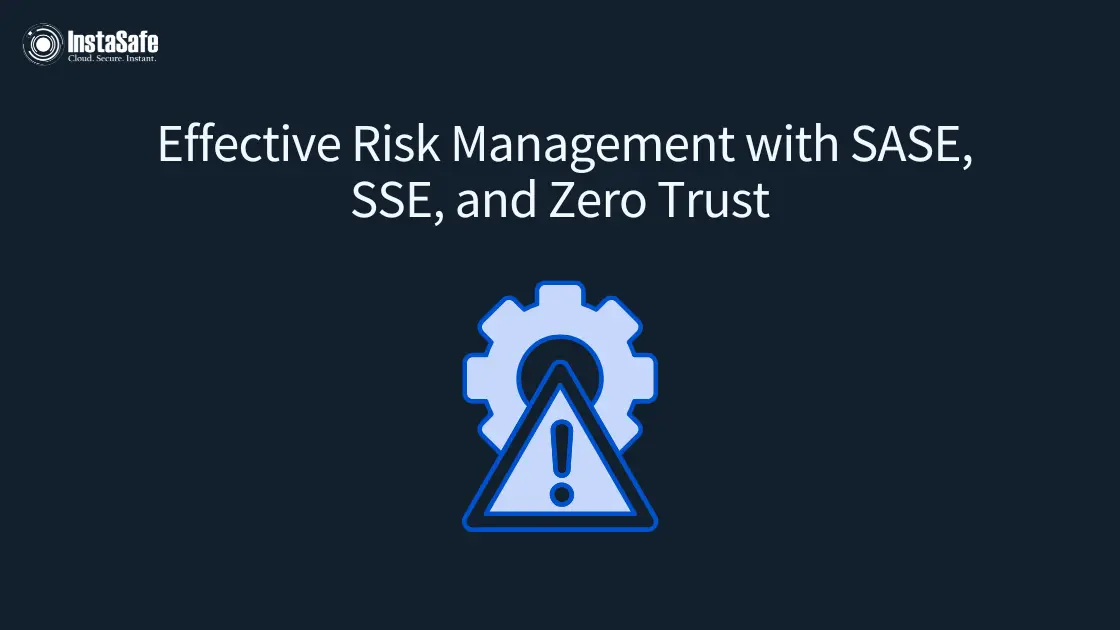Effective Risk Management with SASE, SSE, and Zero Trust

The traditional network perimeter has dissolved as applications move to the cloud, allowing employees to work from anywhere. This shift demands a fundamental change in how we approach risk management.
Three frameworks have emerged as essential components of modern security architecture: Secure Access Service Edge (SASE), Security Service Edge (SSE) and Zero Trust. Understanding how these concepts work together creates a robust foundation for comprehensive risk management services that protect organisations in this new environment.
Understanding the Core Concepts: SSE, SASE and Zero Trust
Security Service Edge: What is SSE?
Security Service Edge (SSE) represents the security portion of the SASE framework. While SASE includes both networking and security components, it focuses exclusively on security services.
These typically include secure web gateway (SWG), zero-trust network access (ZTNA), cloud access security broker (CASB), and firewall-as-a-service (FWaaS) capabilities. Security Service Edge solutions consolidate these functions into a unified cloud service that protects users, devices and applications from threats regardless of their location.
As organisations increasingly adopt cloud-based applications and support remote work, SSE has become essential for implementing effective types of risk management strategies that address the expanded attack surface created by these changes.
Secure Access Service Edge: What is SASE?
SASE (Secure Access Service Edge) is a cloud-based security model that combines network security functions with wide-area networking (WAN) capabilities.
Introduced by Gartner in 2019, SASE merges network security services like secure web gateways, firewall-as-a-service and zero trust network access with WAN capabilities to support the dynamic, secure access needs of organisations. By delivering these services from the cloud, SASE creates a single, integrated security platform that follows users wherever they go.
This eliminates the need for multiple-point solutions and simplifies security management. With SASE, security policies are applied consistently regardless of user location, device type or resource being accessed, making it a cornerstone of modern risk management.
What is Zero Trust?
Zero Trust security depends on "never trust, always verify." This model assumes breach and validates each request as if it came from an untrusted network, unlike standard security models that trust everything within the network boundary.
This approach needs robust identity verification for every user as well as device that is trying to access resources, regardless of whether they are inside or outside the network perimeter. Zero Trust relies on micro-segmentation, least privilege access and continuous monitoring and validation.
By implementing Zero Trust principles, organisations can significantly reduce their vulnerability, making it a fundamental component of comprehensive risk management services in today's world.
Common Risk Management Challenges in the Modern Enterprise
Expanding Digital Perimeters
The dissolution of traditional network boundaries has fundamentally transformed risk management. With applications migrating to cloud environments and remote work becoming standard, organisations struggle to implement effective risk management services that protect distributed resources.
Evolving Threat Landscape
Sophisticated cyberattacks continuously challenge existing types of risk management approaches. Ransomware, supply chain compromises and advanced persistent threats exploit gaps in fragmented security architectures.
Implementing Zero Trust principles becomes critical as organisations recognise that traditional perimeter-based defences cannot counter threats targeting users and data across multiple environments.
Regulatory Compliance Complexities
Organisations face increasing regulatory requirements around data privacy and protection. Such compliance often mandates a demand for comprehensive risk management controls and documentation.
Security Service Edge solutions help address these challenges by providing consistent policy enforcement and visibility across environments, simplifying the compliance verification process while reducing potential gaps.
Resource and Expertise Constraints
Security teams lack sufficient staff and expertise to manage complex security tools effectively. Alert fatigue and security debt create additional vulnerabilities in risk management services.
The integrated nature of SASE helps address these challenges by consolidating security functions, reducing management complexity and enabling more efficient allocation of limited security resources.
Business Agility Requirements
Balancing security with business needs creates significant risk management tension. Zero Trust and Security Service Edge architectures help reconcile these competing priorities by providing security that follows users, devices and data rather than enforcing rigid perimeter controls that hinder legitimate business activities.
How SASE, SSE and Zero Trust Mitigate Cybersecurity Risks?
Risk Reduction with SASE
SASE (Secure Access Service Edge) significantly reduces cybersecurity risks by consolidating network and security functions into a unified cloud service. This integration eliminates security gaps between disparate solutions that attackers often exploit.
By delivering consistent risk management capabilities at the network edge, SASE protects users regardless of their location or device. The architecture's ability to apply security policies dynamically based on identity and context prevents many common attack vectors.
Traditional security approaches create blind spots when users access resources from multiple locations and devices. SASE solves this problem by providing continuous monitoring and protection that follows the user.
This comprehensive visibility enables more effective types of risk management, allowing organisations to detect and respond to threats faster. Additionally, SASE's cloud-based delivery model ensures security controls remain updated against emerging threats without requiring manual intervention, further reducing organisational risk exposure.
SSE's Role in Risk Management
Security Service Edge forms the security core of SASE, delivering critical protection capabilities, including secure web gateways, CASB and ZTNA. These integrated services create layers of defence that work together to implement comprehensive risk management services.
While traditional approaches relied on perimeter defences that attackers could bypass, SSE focuses on protecting data and applications directly, reducing the attack surface regardless of where resources reside.
Data protection capabilities within Security Service Edge solutions directly address data leakage risks that traditional security tools often miss. By implementing consistent data policies across all environments, SSE significantly improves risk management effectiveness.
Its ability to provide real-time threat prevention for both known and unknown threats through advanced inspection techniques further enhances security posture. Organisations leveraging SSE gain greater visibility into user behaviour and application usage, enabling proactive risk management rather than merely reactive responses after breaches occur.
Zero Trust as a Foundation for Risk Management
Zero Trust fundamentally transforms risk management by eliminating implicit trust from security architecture. Traditional approaches trusted users and devices inside the network perimeter, creating significant vulnerability to insider threats and compromised credentials.
By requiring continuous verification of every access request, Zero Trust dramatically reduces these risks. This method limits credential theft by restricting authorised users' access to resources.
Microsegmentation, a core Zero Trust principle, prevents breaches by limiting lateral movement within networks. This capability addresses one of the most dangerous aspects of modern attacks. Zero Trust also enhances risk management services through continuous monitoring and behavioural analysis that can identify anomalous activities indicating compromise.
By implementing least privilege access controls across all environments, Zero Trust creates multiple security layers that must be breached for attackers to access sensitive resources, significantly improving overall security posture.
Best Practices for Implementing SASE, SSE and Zero Trust
Start with the Security Requirements Assessment
Begin your risk management journey by identifying specific security needs and existing gaps. Evaluate current threats against your organisation and prioritise SASE components that address your most critical security challenges.
Develop a Phased Implementation Plan
Implement Security Service Edge and Zero Trust in planned stages rather than attempting complete transformation immediately. Target high-risk areas first while developing expertise in these new risk management services.
Focus on Identity and Access Management
Strong identity controls form the foundation of effective zero-trust architecture. Implement multi-factor authentication and context-aware access policies as early priorities in your risk management strategy.
Integrate Data Protection Capabilities
Ensure your SASE implementation includes robust data security controls. Apply consistent data protection policies across all environments to prevent leakage and address regulatory types of risk management requirements.
Prioritise User Experience
Balance security with usability when implementing Zero Trust and Security Service Edge. Excessive friction will drive shadow IT behaviours, creating new risk management challenges that undermine security objectives.
Measure and Communicate Security Improvements
Develop metrics that demonstrate how SASE and Zero Trust enhance security posture. Regularly share these achievements with leadership to maintain support for ongoing risk management services investments.
Conclusion
The integration of SASE, Security Service Edge and Zero Trust creates a powerful framework for modern risk management. Together, these approaches address the security challenges of today's distributed enterprises by moving protection closer to users and data.
Organisations implementing these technologies gain more effective risk management services that adapt to changing business needs while maintaining strong security. As cyberthreats continue to evolve, this integrated approach provides the flexibility and protection needed to safeguard digital assets in an increasingly complex landscape.
Instasafe Zero Trust delivers seamless protection by eliminating threats at every access point. Our security follows users everywhere, ensuring consistent policy enforcement across your borderless enterprise without compromising performance or productivity.
Trust nothing, verify everything.
Frequently Asked Questions (FAQs)
- How is SASE different from traditional network security approaches?
SASE delivers security from the cloud, eliminating multiple standalone tools. This integrated approach provides consistent risk management everywhere users work.
Traditional security focuses on fixed locations, while SASE follows users, making it ideal for distributed organisations facing modern cyber threats requiring advanced types of risk management.
- Can Zero Trust work effectively without implementing a full SASE architecture?
Organisations can implement Zero Trust principles independently by starting with identity controls and least privilege access. This approach delivers immediate security enhancements and supports the development of progressive risk management services.
However, combining Zero Trust with SASE ultimately provides more comprehensive protection and operational simplicity for complete risk management.
- What are the most common challenges organisations face when implementing SASE and Zero Trust?
The journey to SASE and Zero Trust often encounters resistance to change and technical integration complexities. Security teams struggle to balance strong risk management with positive user experiences.
Success requires executive support, phased implementation targeting high-risk areas first and continuous training. Cultural adaptation remains as challenging as the technical types of risk management transformations.
- What is the difference between SASE and SSE?
SASE includes both networking (SD-WAN) and security components in one integrated framework, while Security Service Edge focuses exclusively on the security elements of SASE without the networking functionality. SSE is a subset of the complete SASE architecture.
